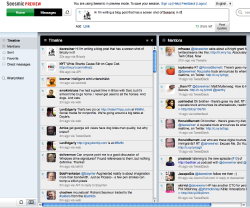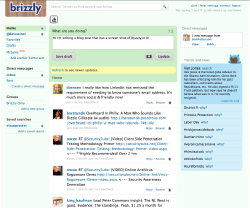Home > Archive > 2009 > September > 6
An rssCloud case study: Brizzly & Seesmic
Sunday, September 06, 2009 by Dave Winer.
 There's a lot of sides to a bootstrap. The idea is to take a something that's highly integrated and break it into pieces. Connect the pieces with open formats, and then show people how to compete. Then each of the pieces becomes a market where users have choice. And when users have choice, competitors must work hard to please them.
There's a lot of sides to a bootstrap. The idea is to take a something that's highly integrated and break it into pieces. Connect the pieces with open formats, and then show people how to compete. Then each of the pieces becomes a market where users have choice. And when users have choice, competitors must work hard to please them. ![]()
It's how we got RSS going in the first place. Netscape got a few content companies to create feeds. They created an aggregator, which we competed with. Two aggregators, that meant more, for sure. And then we made our blogging software produce feeds and worked with lots of publishers. Now blogging software updates millions of feeds every day. But at one point there were just a half-dozen feeds and two aggregators. ![]()
There's lots of competition in the market for Twitter clients. There's a raging battle between a dozen teams all of whom are vying for your attention. Each of them wants to produce the product that attracts the most users. However at the center of the market there is no competition, so improvements come slowly. Our goal is to change that. ![]()
Now, two excellent examples of clients are Seesmic and Brizzly. There are many others but these are the two that I use, so I am most familiar with them. Here are screen shots of the two products. (Click on the thumbs to see larger versions.) ![]()
There are two ways they can support rssCloud, and help the bootstrap give more choice to users, and potentially free themselves to create more features without having to wait for Twitter. ![]()
1. Allow your users to subscribe to cloud-enabled feeds. Right now, most of those are the 1151 feeds of the people I subscribe to. But soon (knock wood) there will be many thousands more, content that you can't get from Twitter. So supporting cloud-enabled feeds now could buy you a head-start on your competition in October or November. ![]()
2. Publish each user's stream of 140-character messages as cloud-enabled feeds, in addition to pushing them through Twitter. Several reasons to do this. First, you provide them a backup, which may be a feature that's of value to them. And they might be able to share their content with 140-character networks formed by others, including Facebook, Yahoo, Google, who knows who. Open formats and protocols create lots of options. Maybe you want to start your own little network of users independent of Twitter. I can tell you -- I do! (And will.) ![]()
Brizzly and Seesmic may not want to do this now. After all it is a holiday weekend in the US. But you never know what the future holds, and it doesn't take much time to think about it. ![]()
![]()
Recent stories
 Dave Winer, 54, pioneered the development of weblogs, syndication (RSS), podcasting, outlining, and web content management software; former contributing editor at Wired Magazine, research fellow at Harvard Law School, entrepreneur, and investor in web media companies. A native New Yorker, he received a Master's in Computer Science from the University of Wisconsin, a Bachelor's in Mathematics from Tulane University and currently lives in Berkeley, California.
Dave Winer, 54, pioneered the development of weblogs, syndication (RSS), podcasting, outlining, and web content management software; former contributing editor at Wired Magazine, research fellow at Harvard Law School, entrepreneur, and investor in web media companies. A native New Yorker, he received a Master's in Computer Science from the University of Wisconsin, a Bachelor's in Mathematics from Tulane University and currently lives in Berkeley, California.
"The protoblogger." - NY Times.
"The father of modern-day content distribution." - PC World.
One of BusinessWeek's 25 Most Influential People on the Web.
"Helped popularize blogging, podcasting and RSS." - Time.
"The father of blogging and RSS." - BBC.
"RSS was born in 1997 out of the confluence of Dave Winer's 'Really Simple Syndication' technology, used to push out blog updates, and Netscape's 'Rich Site Summary', which allowed users to create custom Netscape home pages with regularly updated data flows." - Tim O'Reilly.
Dave Winer
© Copyright 1994-2009 Dave Winer
Last update: 9/6/2009; 9:30:57 AM Pacific. "It's even worse than it appears."

